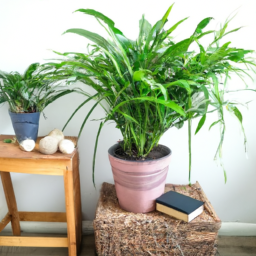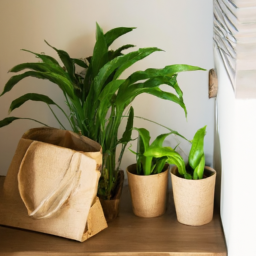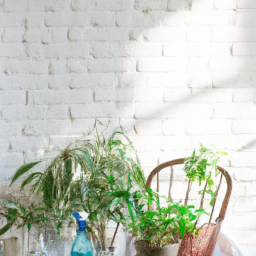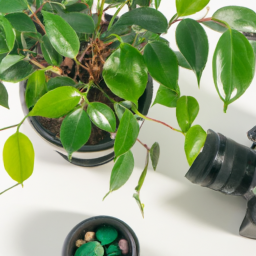
Are you looking for the perfect spot to store your indoor plants? Whether you have a green thumb or are just starting to bring some greenery into your home, finding the right place to keep your plants is essential for their health and well-being. In this blog post, we will explore some of the best locations to store indoor plants to ensure they thrive and add beauty to your living space. So, if you’re wondering “Where to Store Indoor Plants,” keep reading for some helpful tips and ideas.
Best Locations for Indoor Plant Storage
As an expert in indoor plant care, I understand the importance of finding the best locations to store your beloved greenery. The right spot can make all the difference in the health and growth of your plants. In this guide, I will walk you through the top locations for indoor plant storage, ensuring that your plants thrive in their new environment.
Sunny Spots
One of the best locations for indoor plant storage is in sunny spots throughout your home. Plants need sunlight to photosynthesize and grow, so placing them in a sunny area is crucial for their health. South-facing windows are ideal for plants that require a lot of sunlight, such as succulents and cacti. East-facing windows are great for plants that need morning sun, while west-facing windows provide afternoon sunlight. If you have limited sunlight in your home, consider investing in grow lights to supplement your plants’ light needs.
When placing your plants in sunny spots, be mindful of direct sunlight exposure. Some plants can get sunburned if exposed to too much direct sunlight, so it’s important to monitor your plants and adjust their placement accordingly. You can also rotate your plants regularly to ensure that all sides receive adequate sunlight.
In addition to windows, sunny spots can also include areas like balconies or patios. Just be sure to protect your plants from extreme weather conditions, such as strong winds or intense heat, to prevent damage.
Humid Environments
Another important factor to consider when storing indoor plants is the humidity levels in your home. Some plants thrive in humid environments, while others prefer drier conditions. Placing your plants in humid environments can help prevent issues like dry leaf tips or brown spots.
Bathrooms are often ideal locations for plants that require high humidity levels, as the steam from showers can create a moist environment. Kitchens can also be good spots, especially near sinks or dishwashers where moisture levels are higher. If your home tends to be dry, consider using a humidifier to increase humidity levels for your plants.
When placing your plants in humid environments, be sure to monitor the moisture levels in the soil and adjust your watering schedule accordingly. Overwatering can lead to root rot, so it’s important to strike a balance between humidity and watering to keep your plants healthy.
Away from Drafts and Heat Sources
When choosing locations for indoor plant storage, it’s important to keep your plants away from drafts and heat sources. Drafts can cause temperature fluctuations that can stress your plants, while heat sources like radiators or vents can dry out the air and soil, leading to dehydration.
Try to avoid placing your plants near drafty windows or doors, as well as air conditioning units or heaters. If you do have to place your plants near a heat source, consider using a humidity tray or misting your plants regularly to maintain moisture levels.
By keeping your plants away from drafts and heat sources, you can help ensure that they remain healthy and vibrant. Pay attention to the temperature and humidity levels in your home, and adjust your plants’ placement as needed to provide them with the best growing conditions.

2. Creative Indoor Plant Storage Ideas
Welcome to our guide on creative indoor plant storage ideas! If you’re looking to add some greenery to your home but are limited on space, don’t worry – we’ve got you covered. In this article, we’ll explore some unique and innovative ways to store indoor plants that will not only help you save space but also add a touch of style to your living space.
Utilize Vertical Space
One of the best ways to store indoor plants in a small space is by utilizing vertical space. There are many creative ways to do this, such as hanging planters, wall-mounted shelves, or a living wall. Hanging planters are a great option for trailing plants like pothos or spider plants, while wall-mounted shelves can be used to display a collection of smaller plants. A living wall, on the other hand, is a vertical garden that can be created using a variety of plants to create a stunning focal point in any room.
When choosing a location for your vertical plant display, make sure to consider the amount of sunlight the plants will receive. Most indoor plants require bright, indirect light, so be sure to place your vertical display near a window or other source of natural light. Additionally, make sure to water your plants regularly, as vertical displays can sometimes dry out more quickly than traditional planters.
Overall, utilizing vertical space is a great way to store indoor plants in a small space while adding a unique and eye-catching element to your home decor.
Repurpose Furniture
Another creative way to store indoor plants is by repurposing furniture. Old bookshelves, cabinets, or even ladders can be transformed into stylish plant displays with just a little bit of creativity. For example, you can use an old bookshelf to create a plant stand by removing some of the shelves and adding planters in their place. Or, you can repurpose a ladder by hanging planters from the rungs to create a vertical plant display.
When repurposing furniture for plant storage, make sure to choose pieces that are sturdy enough to support the weight of the plants and soil. Additionally, consider the aesthetics of the piece and how it will fit into your existing decor. You can also add a personal touch by painting or staining the furniture to match your style.
Repurposing furniture is a fun and creative way to store indoor plants while adding a unique and personalized touch to your home decor.
Create a Plant Nook
If you have a small corner or nook in your home that is not being used, consider turning it into a plant nook. A plant nook is a dedicated space for storing and displaying indoor plants, and can be created using a variety of materials such as shelves, plant stands, or even a small table. This can be a great way to showcase your plant collection and create a cozy and inviting atmosphere in your home.
When creating a plant nook, make sure to choose plants that will thrive in the space. Consider the amount of light the plants will receive, as well as the humidity levels in the room. You can also add decorative elements such as fairy lights, candles, or artwork to enhance the ambiance of the space.
Overall, creating a plant nook is a great way to store indoor plants in a small space while adding a touch of greenery and style to your home.

Factors to Consider When Choosing a Spot for Indoor Plants
Amount of Light
One of the most important factors to consider when choosing a spot for your indoor plants is the amount of light that they will receive. Different plants have different light requirements, so it’s important to take this into account when deciding where to place them in your home. Some plants thrive in bright, direct sunlight, while others prefer low light conditions. Make sure to research the specific light needs of each of your plants so that you can place them in the most suitable spot.
In general, south-facing windows tend to receive the most sunlight, while north-facing windows receive the least. East-facing windows get the most gentle morning light, while west-facing windows get the harsh afternoon sun. Consider the direction that your windows face when deciding where to place your plants, and make sure that they are getting the right amount of light for their needs.
If you don’t have access to natural light in your home, you can also consider using artificial grow lights to provide your plants with the light that they need. Just make sure to place the lights at the appropriate distance from your plants, as too much light can be just as harmful as too little.
Humidity Levels
Another important factor to consider when choosing a spot for your indoor plants is the humidity levels in your home. Some plants thrive in high humidity environments, while others prefer drier conditions. If you live in a dry climate or have central heating or air conditioning in your home, you may need to take steps to increase the humidity levels for your plants.
You can increase humidity levels by placing a humidifier near your plants, grouping plants together to create a microclimate, or misting your plants with water regularly. You can also place a tray of water near your plants to help increase the humidity levels in the air. Make sure to research the specific humidity needs of your plants so that you can provide them with the best growing conditions.
If you live in a very humid environment, you may need to take steps to decrease the humidity levels for your plants. Make sure to provide good air circulation around your plants and avoid overwatering, as excessive moisture can lead to mold and mildew growth.
Temperature
The temperature of your home is another important factor to consider when choosing a spot for your indoor plants. Most plants prefer temperatures between 65-75 degrees Fahrenheit during the day and slightly cooler temperatures at night. Avoid placing your plants near drafty windows or doors, as sudden temperature changes can stress your plants and make them more susceptible to pests and diseases.
If you live in a very cold climate, you may need to provide additional heat for your plants during the winter months. You can use a space heater or heating mat to keep your plants warm, or simply move them to a warmer spot in your home. Just make sure to avoid placing your plants near heat sources such as radiators or vents, as this can cause them to dry out and suffer from heat stress.
On the other hand, if you live in a very hot climate, you may need to provide additional shade or ventilation for your plants to prevent them from overheating. Consider placing your plants in a spot with indirect sunlight or using a fan to circulate the air around them. Make sure to research the specific temperature needs of your plants so that you can provide them with the best growing conditions.
Key Takeaways
When it comes to bringing the beauty of nature indoors with indoor plants, the question of where to store them can be a crucial one. The ideal location for your indoor plants will depend on a variety of factors, including the specific needs of the plant, the amount of natural light available in your home, and the overall aesthetic you are trying to achieve.
One important consideration when deciding where to store your indoor plants is the amount of natural light they require. Some plants, like succulents and cacti, thrive in bright, direct sunlight, while others, like ferns and peace lilies, prefer indirect light. Additionally, some plants may need to be rotated periodically to ensure they receive an even amount of sunlight on all sides. Ultimately, the key is to find a spot in your home that provides the right amount of light for your specific plants to flourish. Whether it’s a sunny windowsill, a well-lit corner, or a spot under artificial grow lights, choosing the right location for your indoor plants can make all the difference in their growth and overall health.
Here are this week’s Top Questions and Answers
Q1: What are some ideal locations to store indoor plants?
A1: When deciding where to place your indoor plants, consider areas with access to natural light, such as near windows or under skylights. Additionally, choose spots with proper air circulation and temperature control to ensure your plants thrive.
Q2: Can indoor plants be kept in bathrooms?
A2: Bathrooms can be suitable locations for some indoor plants, as they tend to have higher humidity levels. Just make sure the plants receive enough light and are not exposed to extreme temperature fluctuations.
Q3: Is it okay to place indoor plants near air conditioning vents?
A3: It is generally not recommended to place indoor plants directly next to air conditioning vents, as the constant airflow can lead to drying out the plants. Instead, try to position them in a location where they can benefit from indirect airflow.
Q4: Can indoor plants be stored in bedrooms?
A4: Bedrooms can be great places to store indoor plants, as they can help improve air quality and add a touch of nature to your space. Just ensure the plants are not placed too close to electronics or other items that may emit heat.
Q5: How can I protect my indoor plants from pets or children?
A5: To protect your indoor plants from pets or children, consider placing them on high shelves, using plant stands, or hanging them from the ceiling. You can also opt for plants that are non-toxic to pets and children to ensure everyone’s safety.
Dr. Olivia Green is a botanist with over two decades of experience in indoor plant cultivation. She holds a Ph.D. in Plant Biology and has dedicated her career to researching plant behavior in controlled environments. Dr. Green is passionate about helping plant enthusiasts master the art of indoor gardening through her extensive knowledge and practical insights.


